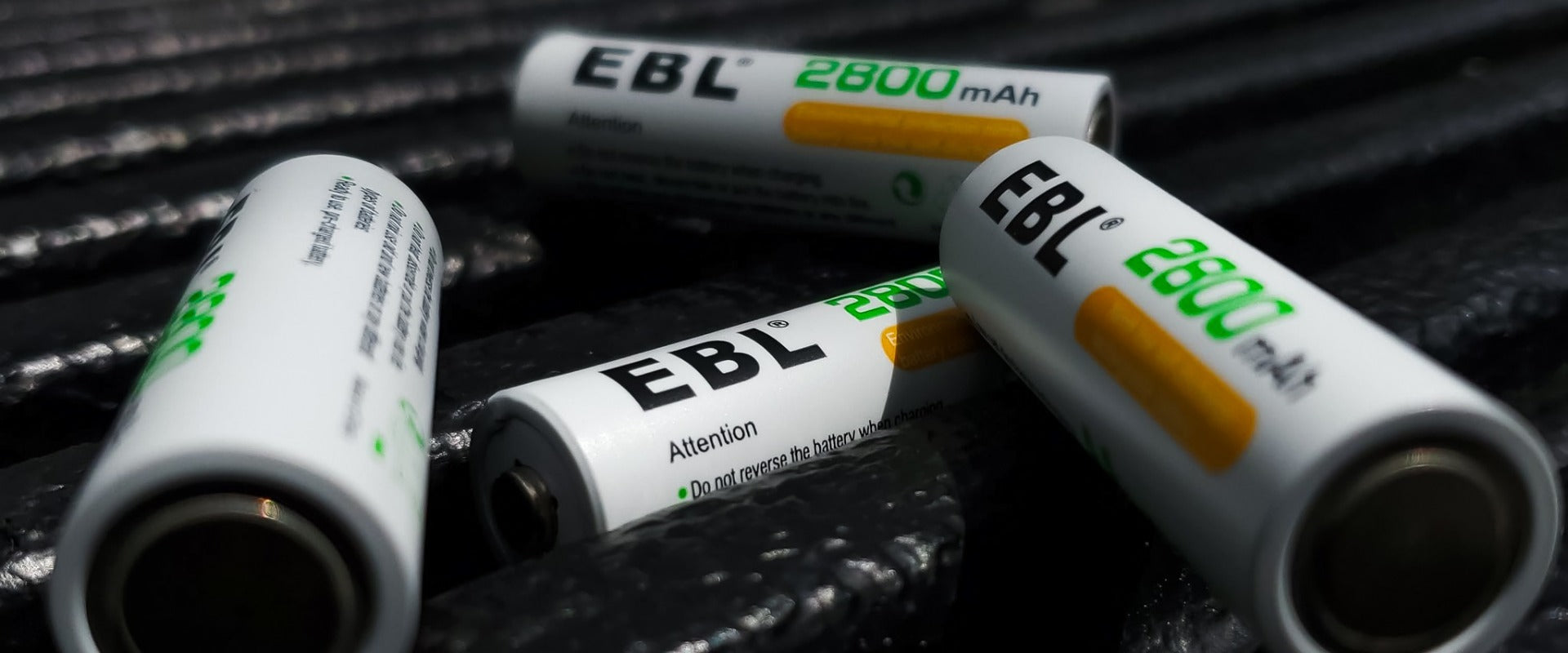Usage Guide for EBL Batteries
Suggestions
Charging:
- Rechargeable batteries should be fully charged before initial use or after prolonged storage.
- Follow the user manual for recommended charging methods.
Storage:
- Store batteries in a cool, dry place.
- Avoid using batteries in enclosed compartments to prevent hydrogen gas buildup.
- Ensure proper ventilation in battery compartments to prevent potential explosions.
- When storing or transporting, please fix the battery separately to prevent external short circuit.
Read the blog for battery storage tips
Handling:
- Charge and discharge batteries every 3 months during long-term storage.
- Use the appropriate charger for your battery type (Li-ion, Ni-Cd, Ni-MH).
- Ensure correct placement of positive and negative terminals when connecting to the charger.
- Turn off devices if battery power drops to avoid over-discharging.
- Disconnect batteries from devices when not in use.
- Hold the connector, not the cord, when disconnecting the battery.
Safety Measures:
- Cool down overheated batteries in a well-ventilated area before charging.
- Keep batteries away from children, and seek medical attention if swallowed.
- Recycle all rechargeable batteries; do not dispose of them.
Warnings
Charging and Discharging:
- Do not reverse charge batteries.
- Avoid mixing new and semi-used batteries to prevent over-discharge.
Physical Handling:
- Do not short-circuit batteries; it may cause permanent damage.
- Do not solder directly on the battery.
- Do not subject batteries to extreme temperatures, overcharging, or overdischarging.
- Do not mix EBL batteries with other brands or different chemistries.
Safety Precautions:
- If batteries exhibit noise, high temperature, or leakage, stop using them.
- Do not touch or handle hot batteries until they cool down.
- Do not remove the outer sleeve or cut into the battery housing.
- Never put batteries into water or seawater.
- Do not disassemble or subject batteries to pressure or shock; it may cause heat generation or fire.
Additional Relevant Questions
Why is my battery not charging?
There are various reasons why a battery may not charge:
- Aging: Over time, batteries naturally age, leading to reduced capacity and diminished charging capability. Aged batteries may struggle to hold a charge or reach the expected charge level.
- Damage: Physical damage or overcharging during use can lead to battery damage, rendering it unable to charge.
- Internal Faults: Internal component failures or short circuits within the battery may hinder charging. This could be due to manufacturing defects or other issues.
- Non-rechargeable Battery: Attempting to charge a non-rechargeable battery can result in failure and potential damage. Ensure the battery is designed for recharging.
- Charger Issues: Using an incompatible or damaged charger can prevent the battery from charging. Charger malfunctions or connection problems may also affect charging effectiveness.
- Battery Protection: Some batteries have built-in protection mechanisms that halt charging when issues arise to prevent safety hazards.
Do I need to recharge the battery if it's fully charged and not in use for a while?
It is advisable to recharge the battery every 3 months if it has been fully charged and remains unused for an extended period. This helps maintain its health and prevents performance degradation.
Is it advisable to rotate the use of batteries or use them together?
The recommendation depends on the specific circumstances. Generally, it's advisable to rotate the use of batteries, meaning to alternate between different batteries to ensure they all receive adequate charging and usage. This helps balance the lifespan and performance of the batteries.
On the other hand, if a device requires the simultaneous use of multiple batteries, it's important to use batteries of the same type, specifications, and similar age to ensure optimal performance and stability when used together.
What are the potential effects of using batteries with different capacities together?
Mixing batteries with different capacities can lead to uneven discharge, charging imbalances, and potential safety risks. It's best to use batteries with similar capacities for optimal performance and safety.
Why do batteries get hot when charging?
Batteries heat up during charging due to the conversion of electrical energy into heat through internal reactions. Factors like internal impedance, charging speed, and battery type, especially in lithium-ion batteries, contribute to this heat.
While some heating is normal, excessive heat can affect battery life and performance. Using proper charging equipment helps ensure safe charging and reduces the risk of overheating.
How can I determine the charging time for batteries?
To calculate the charging time, you should first identify the output current of the battery charger you're using. Then, use the formula:
Charging time (rough estimate) = Battery capacity / Output current
From the blog

NiMH batteries are not lithium batteries. While both fuel countless devices, from remotes to smartphones, they belong to fundamentally different chemical families. NiMH (Nickel-Metal Hydride) batte...

How Lithium-Ion Batteries Are Made Step by Step
A Lithium-ion battery comes to life through a multi-stage, precise process. Start with raw materials that become carefully engineered layers inside each cell. These layers include the cathode, anod...

NiMH vs LiPo Batteries: What Is The Difference And How to Choose
When you compare a NiMH with a LiPo battery, you see clear differences. NiMH batteries give you more safety and simple handling. LiPo batteries, on the other hand, offer higher performance and ligh...


